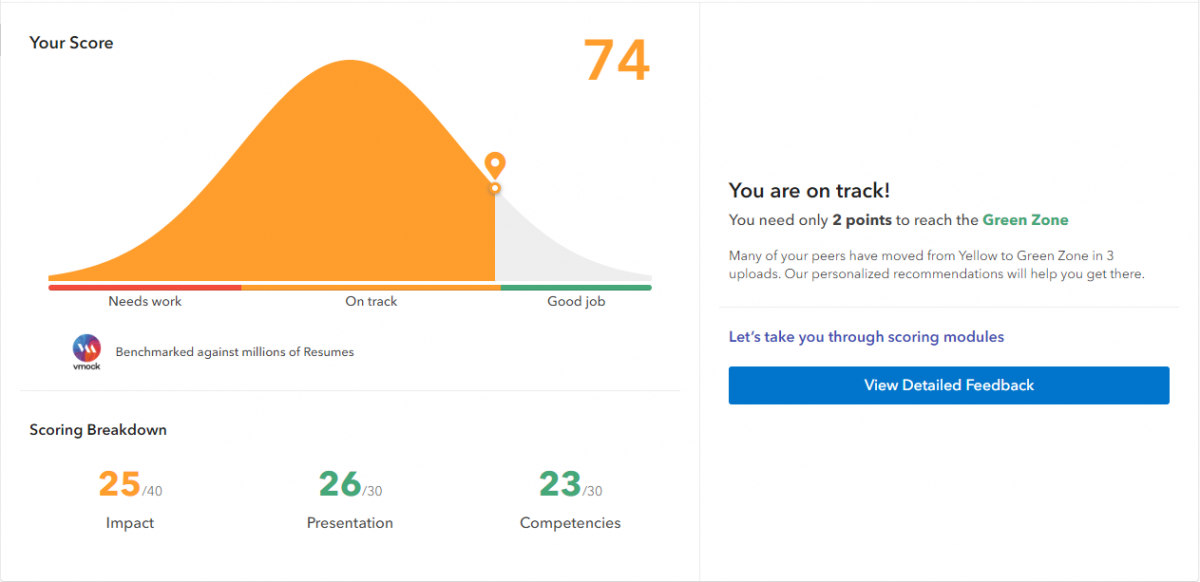You have /5 articles left.
Sign up for a free account or log in.

Istockphoto.com/SDI Productions
When college students need help with their résumés, some now will be turning to algorithms rather than advisers.
In the last decade, a growing number of large companies have started hiring using applicant tracking systems, AI-based platforms that scan résumés for keywords and rank job candidates.
Similarly, video interviewing platforms that use algorithms to evaluate a candidate’s voice, gestures and emotions have become ubiquitous in some industries. HireVue, the most well-known of these platforms, has drawn accusations of being pseudoscientific and potentially exacerbating bias in hiring.
The frustration many job candidates voice when coming up against these platforms is that they have no way of knowing what they could have done better. The systems give no feedback to candidates.
So what if students, job seekers and career advisers could use the AI for themselves?
To save time and money, provide flexibility, and answer increasing calls to improve student job outcomes, many colleges are trying to do just that, by employing AI-based résumé-scanning platforms.
VMock Gains Ground
VMock, founded in 2012, is one of the more popular AI-based résumé scanners, with over 200 partner institutions globally.
To hear Salil Pande, who founded VMock along with his wife, Kiran Pande, tell it, his goal is to democratize career counseling.
“I started this company not to just help the most amazing institution in the world to become even more amazing and solve all their problems,” he said. “I want to actually help all those students and all those job seekers who actually have no support.”
To be sure, though the company has made moves into the community college and small public four-year college market, early adopters were mostly graduate schools of business at highly selective institutions like the University of Chicago.
Though both Pande and career center staff emphasize that VMock will help a student whether their résumé is evaluated by a real person or by a computer, Pande says helping students who find themselves up against algorithm-influenced hiring is one of his goals.
“All of the resources are available to the companies. Companies are able to analyze résumés using applicant tracking systems, and applicant tracking systems are becoming so sophisticated,” he said, noting that the systems have moved beyond just keyword scanning. “We want job seekers to be so sophisticated that they are not one step behind corporate, they are one step ahead of corporate.”
Though career center staff at many universities emphasize that VMock is not a replacement for a human adviser, the platform has become an increasingly entrenched part of the career development process.
At the University of Houston Downtown, in order to peruse the career center’s job board and apply for roles, business students need to get a VMock score of at least 85. Before they can meet in person with a career adviser to talk about their résumé, students need to upload at least four versions of their résumé to the platform.
“We always want to make sure that anytime they put a résumé in front of an employer, they’re going to make a good impression,” said Brett Hobby, director of the business career center at the university. “Unfortunately, the best way to do that is to just hold the carrot of the jobs in front of them.”
Hobby said using VMock saves staff time and is cheaper than hiring another team member, which the center wouldn’t be able to do. “It has allowed us to recoup so much time that we used to spend on the most basic feedback to give on résumés,” he said. “We can use that time to do other things, like employer outreach and meeting with students on deeper things like preparing to interview and putting together a job search plan and getting an internship.”
At Ramapo College of New Jersey, VMock has been incorporated into the graduation process. In order to graduate, students must have a résumé approved by the career center, which directs them to use VMock as a first step.
“What we were seeing when we looked at the data for appointments was that in our résumé reviews, we were spending a lot of time helping students with things like presentation and format of their résumé and not as much time on the more substantive pieces,” said Beth Ricca, director of the Ramapo career center.
Ricca emphasized that VMock will never take the place of personal advising from a trained professional at the college who can help a student tailor a résumé for a specific job.
“We have found that we are now able to have much more meaningful conversations with students to work with them on tailoring that résumé for specific positions as opposed to spending time on the basic pieces of the résumé,” she said.
Career center staff at institutions such as Northwestern University and Villanova University said that while the platform has been very helpful in providing flexibility to students and improving résumés on the whole, they take a slightly more lax approach to VMock and résumé counseling. At Northwestern, although students are encouraged to use the platform, especially on weekends and breaks when the career center might not be open, there is no requirement to do so, said Mark Presnell, executive director of Northwestern Career Advancement.
At the Ramapo career center, staff members also work with students to try to help them understand when a VMock-approved résumé might be a plus and when it might be necessary. A graphic design student, Ricca said, might want to demonstrate some creative design skills on their résumé, which is great when handing the paper to a real person at a career fair. But within applicant tracking systems, graphic design, text boxes and creative résumé formatting can all severely hold a candidate back.
“The résumés that are coming out of VMock are ready for these applicant tracking systems, and that’s the direction that so many employers are going toward,” Ricca said. “We really want to give our students the best chance at having a person review their résumé. And if the applicant tracking systems aren’t finding what they’re programmed to look for, our students aren’t even getting that chance.”
Boston University, in a document of VMock tips for students, also advised graphic design or other creative industry students to have two versions of their résumé, one with a conventional layout.
The document also illustrates some of VMock’s stricter guidelines. According to the tip sheet, a résumé is docked 15 points for using parentheses around a phone number's area code. A section titled “Leadership & Activities” is fine, but one titled “Leadership and Activities” is not. Students are advised not to describe their field of study as a "major" and not to use dashes or arrows in the place of dot bullets.
The platform does allow colleges some degree of customization. Any person, at a college or not, can upload their résumé to the main VMock site and, for about $20, get detailed feedback. That résumé is assessed against millions of others.
But when colleges buy a license for their students, staff have some control over how the categories (presentation, competencies and impact) are weighed and what students are assessed against. Career centers are asked to upload sometimes thousands of their own sample résumés, so that students are then “benchmarked” against their peers. Staff can establish different standards for business students and engineering students, for example.
They can also tweak some of the platform’s established rules and make their some of their own. At Villanova University, for example, students are asked to use their university email.
Pande says VMock is looking to expand. The company already has completed a pilot study in a high school setting and is in the process of releasing new tools that go beyond the résumé scanner. These tools can advise students on their LinkedIn profiles, ideal career paths based on work experience or on their elevator pitches. In the latter, a student can record a quick spiel and get feedback on their emotional signals, facial expressions and gestures, similar to the way HireVue assesses job candidates for companies.
Northwestern University and the University of Nebraska at Lincoln are among institutions that have launched Aspire, the company’s LinkedIn tool.
Jennifer Freeman, a program director at Jobs for the Future, said that the technology can be hugely helpful for people who advise students, but it is not a replacement for human feedback.
Though college career center funding has not on the whole seen a decrease, she said, colleges increasingly are being asked to improve student job outcomes.
“All of postsecondary -- two-year colleges, four-year colleges -- everyone’s under a lot of pressure to show their value,” she said. “For private colleges it’s about showing your value. For public institutions that serve lower-income people, it’s also about showing your value, but it's also about showing that you are actually helping a population that really needs the help.”
Pande expressed a similar sentiment. “Education is going through quite a bit of twists and turns,” he said. “Essentially what used to be one of the objectives, which was let’s get our students career ready, now that’s front and center.”




